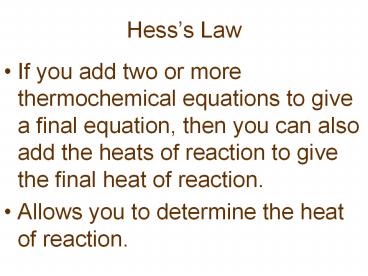Hess - PowerPoint PPT Presentation
1 / 13
Title:
Hess
Description:
Hess s Law If you add two or more thermochemical equations to give a final equation, then you can also add the heats of reaction to give the final heat of reaction. – PowerPoint PPT presentation
Number of Views:201
Avg rating:3.0/5.0
Title: Hess
1
Hesss Law
- If you add two or more thermochemical equations
to give a final equation, then you can also add
the heats of reaction to give the final heat of
reaction. - Allows you to determine the heat of reaction.
2
Manipulations
- If you reverse a reaction, change the sign of ?H.
- C O2 ? CO2(g) -393.5kJ
- CO2(g) ? C O2 393.5kJ
3
Manipulations
- If you double/triple/etc. a reaction, you also
must double/triple/etc. ?H. - C O2 ? CO2(g) -393.5kJ
- 2C 2O2 ? 2CO2(g) 2-393.5kJ
4
Example
- Work backwards
- Given the following, calculate ?H for
- 4NH3(g) 3O2(g) --gt 2N2(g) 6H2O(l)
- 2N2O(g) --gt O2(g) 2N2(g) ?H -164kJ
- 2NH3(g) 3N2O(g) --gt 4N2(g) 3H2O(l) ?H
-1012kJ - Answer -1532 kJ
5
Standard Enthalpy of Formation
- Represented by ?Hf
- Sometimes calorimeters can not be used to find ?H
(like if the process is very slow) - Shows how much energy is required to make 1 mole
of a compound from its elements with all
substances in their standard state - Table 6.2 in your book
6
Standard State Definition
- COMPOUND
- Pressure 1 atm
- Pure liquid or solid
- If in solution, concentration 1M
- ELEMENT
- Pressure 1 atm
- Temperature 25C
- State whatever state it exists in these
conditions
7
Calculating
- DH0reaction ?npDHf0(products)?nrDHf0(reactants)
- ? means sum of
- np is moles of productnr is moles of reactant
- If dealing with an element, the DHf0 is zero
8
Example
- Calculate the change in enthalpy
- CH4(g) 2O2(g) ? CO2(g) 2H2O(l)
- Answer
- Products -393.5kJ 2(-285.8kJ)
- -965.1kJ
- Reactants -74.86kJ 2(0.0kJ)
- -74.86kJ
- P-R -965.1kJ-(-74.86kJ) -890.24kJ
9
Fossil Fuels
- When decayed plants are burned, the energy stored
in them can be used - Petroleum and natural gas (hydrocarbons)
- Coal creates about 23 of U.S. energy
10
Hydrocarbons
- Prefixes are the same in organic chemistry
- Meth-
- Eth-
- Prop-
- But-
- Pent-
- Hex-
- Hept-
- Oct-
- Suffixes represent different bonding/compounds
11
Environmental Impacts
- Greenhouse effect CO2 created from combustion of
fossil fuels absorbs infrared radiation given off
by the earth and does not allow it to leave the
atmosphere - H2O can also absorb radiation (humidity), but
earths H2O has not changed much
12
New Energy Sources
- Coal gasification creates a gaseous form of coal
(syngas) that is easily transported and reacted
with oxygen in a combustion reaction, releasing
energy - This material can be used to produce other fuels
like methanol
13
New Energy Sources
- Coal Slurries coal ground up and mixed with
water and used instead of solid coal in power
plants














![[PDF] READ] Free Ebersole and Hess' Gerontological Nursing & Healthy A PowerPoint PPT Presentation](https://s3.amazonaws.com/images.powershow.com/10126992.th0.jpg?_=202409090910)
















